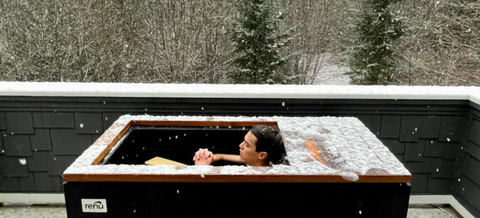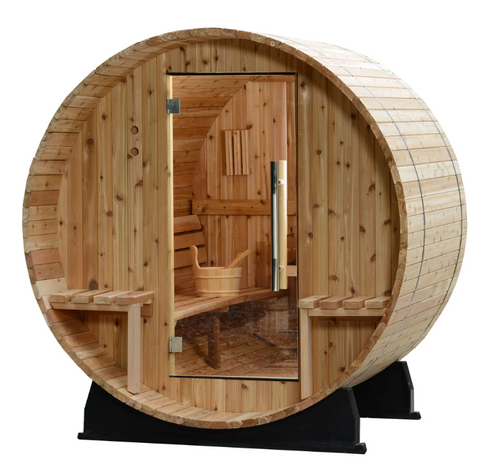In Japan, taking hot baths has played a prominent role in the culture for centuries. In fact, people in Japan take more hot baths than any other people in the world. As more research is being done to learn the benefits of taking hot baths, studies are finding this might be why the Japanese are one of the healthiest nations and have the longest life expectancies in the world.
It seems that bathing for the pure enjoyment of it doesn’t have to be a guilty pleasure, it could actually improve your health. Let’s dive deeper into this ancient practice so you can discover the ways you could benefit.
A Brief History of Japanese Soaking Tub
Soaking in a tub of hot water started in ancient Japan as a ritual called ablution, which means purification. This ritual became a ceremonial part of Japanese culture to represent spiritual and physical renewal, cleansing the body and purifying the soul.
The traditional method of ablution began with a shower to clear the skin of impurities. This shower was completely natural, not relying on using soap. After the shower, it was time for immersion up to the chest in a traditional Japanese soaking tub called an Ofuro. Bathers would sit down and soak in a deep wooden tub filled with mineralized water nearly 120˚F in temperature, much like the hot spring waters of a natural spa.
Modern versions of these Japanese soaking tubs can be found today in the bathrooms of houses, apartments, luxury spas, and many hotels spanning the country. Soaking tubs are quickly becoming one of the must-have items for contemporary bathrooms, while still adhering to the ceremonious aspects of the ancient Japanese ritual.
Although Japanese soaking tubs have risen in popularity for modern bathrooms there, much of why people appreciate having one in their home is because they’re larger and more feature-filled than a standard bathtub.
What Are the Benefits of Japanese Hot Soaks?
People in Japan are far more focused on comfort when it comes to their soaking tubs than in the West, where people lie down in their baths with their legs stretched out and their shoulders exposed and unsupported. For the ultimate in relaxation, it’s hard to beat a Japanese soaking tub, with the comfortable and fully-submerged seating position. What other benefits do these tubs provide?
Heat
One key benefit of hot soaks comes from raising the body temperature. Heating up the body causes the arteries to relax and expand, increasing circulation. More blood flow increases oxygen and nutrition to the cells in the body along with carrying away carbon dioxide and other wastes. The boost in circulation creates a restorative feeling while soaking in the bath, melting away stress and relaxing the mind.
You can also increase the benefits of heat by jumping into a cold plunge tub after your hot soak, a process called contrast therapy. Exposure to cold has the opposite effect on blood vessels, causing them to constrict after being dilated from the heat. This rapid contraction helps improve the elasticity of blood vessels, promoting a healthy cardiovascular system.
Buoyancy
The buoyancy that comes from your body floating in water is much greater in a tub filled with water up to your shoulders. When you’re soaking, your body only needs to support one-tenth of your weight. This extra support provided by buoyancy allows your muscles to rest, increasing the overall level of relaxation compared with a regular bathing experience.
Hydrostatic Pressure
When you apply gentle compression to the muscles, blood is returned to the heart, and circulation is increased. By being completely immersed in a bath, the weight of the water around your body exerts hydrostatic pressure all over, gently compressing all of your muscles. This is especially helpful for the legs and lower body when you want to alleviate swelling and inflammation.
Comfort
What makes Japanese soaking tubs so ideal for unwinding after a long day? Rather than lying down as you do in a regular tub, you sit upright on a built-in bench. With a straight back, your feet fall below your waist, and your head and shoulders receive natural support from your spine. All of the pressure on your shoulders and neck are alleviated when you’re submerged in a Japanese hot soak.
Ritual
Soaking in a deep tub of hot water is a meditative, restorative experience that provides a ritual to ground yourself each day. Most people will get into the hot water and soak for approximately ten minutes. A good rule of thumb regarding when to get out is when you start developing perspiration on your face. This is a sign your body temperature has risen enough, and it’s time to get out.
Promoting Health and Wellbeing
What about the health and well-being benefits of a Japanese hot soak? The ablution ritual has positive therapeutic effects aside from mere relaxation. Some examples include:
- Detoxifying the body of pathogens by stimulating the lymphatic system
- Improving cardiovascular performance through vasodilation
- Producing a calming effect that reduces stress and anxiety
- Boosting metabolic rates and digestion
- Strengthening the immune system
- Cleansing the skin of impurities
Should You Get a Cold Bath for Japanese Hot Soaks?
Getting your very own Japanese hot soak tub requires plenty of research to fully understand whether or not it will serve your needs for the long term. Will you also be using the tub for contrast therapy in conjunction with a cold plunge tub? If so, you’ll want to ensure you have enough space and power connections to accommodate two tubs of water.
Combining a cold plunge tub with your hot soak routine can deliver enhanced benefits for both body and mind. Read more about the added benefits of contrast therapy here.
Taking a plunge in a Japanese soaking tub could provide more for your health and wellbeing than the enjoyment of taking time out to relax, recharge, and reflect on your day. To learn more about the benefits of hot and cold tub therapies for the body and mind, explore all of our therapeutic solutions today.















